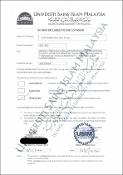Options
Green Synthesis, Characterization and Antibacterial Activity of Silver Nanoparticles-Kaempferol (Agnp-K) Towards Methicillin-Resistant Staphylococcus Aureus (Mrsa)
Date Issued
2024-05
Author(s)
Ariff Haikal Bin Hairil Anuar
Universiti Sains Islam Malaysia
Abstract
This study aims to characterize silver nanoparticles-kaempferol (AgNP-K) and its
antibacterial activities against methicillin-resistant Staphylococcus aureus (MRSA).
Nowadays, MRSA is a worldwide public health threat due to the resistance towards
current antibiotics. Kaempferol was chosen due to its antibacterial capability. Green
synthesis methods have been used to synthesize AgNP-K with the influence of
temperature and different concentrations of silver nitrate and kaempferol
(AgNO3:kaempferol). Sample C (AgNP-K 1:1 60/168) was synthesized with 1 mM
concentration of kaempferol meanwhile sample Y (AgNP-K 1:2 60/168) with 2 mM of
kaempferol. Characterization of sample C and sample Y were performed using UVVisible
Spectroscopy (UV-Vis), zetasizer, transmission electron microscope (TEM),
scanning electron microscope with a dispersive X-ray spectrometer (SEM-EDX), X-ray
diffraction (XRD) and fourier transform infrared (FTIR). The presence of dark-brown
colour in the solution indicated the formation of AgNP-K. UV-Visible absorption
spectrum of the synthesized AgNP-K, sample C and sample Y showed a broad peak at
range of 390 nm - 530 nm of wavelength. TEM, zetasizer and SEM-EDX results showed
physical properties of sample C and sample Y such as morphology and size. The
morphology analysis showed sample C and sample Y were in spherical shape. The size
for sample C showed by zetasizer and TEM was 120.4 nm and 21.1487 ± 4.0183 nm
respectively. Meanwhile, sample Y was 226.5 nm for zetasizer and 28.3604 ± 5.3418
nm in TEM. XRD analysis confirmed that AgNP-K was in crystalline phase structure,
while FTIR showed (-OH) group absence in sample C and sample Y thus indicating that
kaempferol was successfully incorporated with silver. Antibacterial activities of five
samples (sample C, sample Y, commercial AgNP, kaempferol and vancomycin) with
different concentrations (1.25, 2.5, 5, and 10 mg/mL) against MRSA were performed
by using disc diffusion assay (DDA), minimum inhibitory concentration (MIC) and
minimum bactericidal concentration (MBC) assay and time-kill assay. In DDA analysis,
AgNP-K showed greater antibacterial activities against MRSA compared to kaempferol
and commercial AgNP. The range values of MIC and MBC on both sample C and
sample Y against MRSA were 1.25 mg/mL – 5 mg/mL, respectively. Time-kill assay
analysis showed AgNP-K displayed bacteriostatic activity while bactericidal from MIC
and MBC results towards MRSA. As conclusion, AgNP-K had been successfully
synthesized from green synthesis method and performed characterization method by six
(6) different instruments. From biological assay conducted showed that AgNP-K
exhibited antibacterial activity against MRSA. As conclusions, silver nanoparticleskaempferol
(AgNP-K), sample C exhibited better antibacterial activity when compared
with sample Y kaempferol and commercial AgNP against MRSA.
antibacterial activities against methicillin-resistant Staphylococcus aureus (MRSA).
Nowadays, MRSA is a worldwide public health threat due to the resistance towards
current antibiotics. Kaempferol was chosen due to its antibacterial capability. Green
synthesis methods have been used to synthesize AgNP-K with the influence of
temperature and different concentrations of silver nitrate and kaempferol
(AgNO3:kaempferol). Sample C (AgNP-K 1:1 60/168) was synthesized with 1 mM
concentration of kaempferol meanwhile sample Y (AgNP-K 1:2 60/168) with 2 mM of
kaempferol. Characterization of sample C and sample Y were performed using UVVisible
Spectroscopy (UV-Vis), zetasizer, transmission electron microscope (TEM),
scanning electron microscope with a dispersive X-ray spectrometer (SEM-EDX), X-ray
diffraction (XRD) and fourier transform infrared (FTIR). The presence of dark-brown
colour in the solution indicated the formation of AgNP-K. UV-Visible absorption
spectrum of the synthesized AgNP-K, sample C and sample Y showed a broad peak at
range of 390 nm - 530 nm of wavelength. TEM, zetasizer and SEM-EDX results showed
physical properties of sample C and sample Y such as morphology and size. The
morphology analysis showed sample C and sample Y were in spherical shape. The size
for sample C showed by zetasizer and TEM was 120.4 nm and 21.1487 ± 4.0183 nm
respectively. Meanwhile, sample Y was 226.5 nm for zetasizer and 28.3604 ± 5.3418
nm in TEM. XRD analysis confirmed that AgNP-K was in crystalline phase structure,
while FTIR showed (-OH) group absence in sample C and sample Y thus indicating that
kaempferol was successfully incorporated with silver. Antibacterial activities of five
samples (sample C, sample Y, commercial AgNP, kaempferol and vancomycin) with
different concentrations (1.25, 2.5, 5, and 10 mg/mL) against MRSA were performed
by using disc diffusion assay (DDA), minimum inhibitory concentration (MIC) and
minimum bactericidal concentration (MBC) assay and time-kill assay. In DDA analysis,
AgNP-K showed greater antibacterial activities against MRSA compared to kaempferol
and commercial AgNP. The range values of MIC and MBC on both sample C and
sample Y against MRSA were 1.25 mg/mL – 5 mg/mL, respectively. Time-kill assay
analysis showed AgNP-K displayed bacteriostatic activity while bactericidal from MIC
and MBC results towards MRSA. As conclusion, AgNP-K had been successfully
synthesized from green synthesis method and performed characterization method by six
(6) different instruments. From biological assay conducted showed that AgNP-K
exhibited antibacterial activity against MRSA. As conclusions, silver nanoparticleskaempferol
(AgNP-K), sample C exhibited better antibacterial activity when compared
with sample Y kaempferol and commercial AgNP against MRSA.
Subjects
File(s)

Loading...
Name
3201480 Introduction.pdf
Size
297.17 KB
Format
Adobe PDF
Checksum
(MD5):29ec85561355f7fc986484f4574e5188
Loading...
Name
3201480 Declaration..pdf
Size
333.68 KB
Format
Adobe PDF
Checksum
(MD5):97041351ddb9d914634394cdb228c3c7